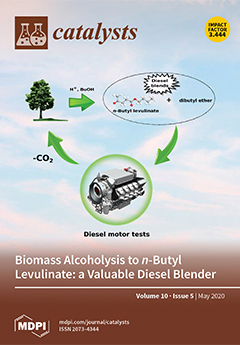A 20 wt% Co-0.05 wt% Pt/γ-Al
2O
3 catalyst was investigated to obtain a fundamental understanding of the effect of CO partial pressure (constant H
2 partial pressure) on important kinetic parameters of the methanation reaction (x vol% CO/25 vol% H
2, x = 3, 5 and 7) by performing advanced transient isotopic and operando diffuse reflectance infrared Fourier transform spectroscopy–mass spectrometry (DRIFTS-MS) experiments. Steady State Isotopic Transient Kinetic Analysis (SSITKA) experiments conducted at 1.2 bar, 230 °C after 5 h in CO/H
2 revealed that the surface coverages, θ
CO and θ
CHx and the mean residence times, τ
CO, and τ
CHx (s) of the reversibly adsorbed CO-s and active CH
x-s (C
α) intermediates leading to CH
4, respectively, increased with increasing CO partial pressure. On the contrary, the apparent activity (k
eff, s
−1) of CH
x-s intermediates, turnover frequency (TOF, s
−1) of methanation reaction, and the CH
4-selectivity (S
CH4, %) were found to decrease. Transient isothermal hydrogenation (TIH) following the SSITKA step-gas switch provided important information regarding the reactivity and concentration of active (C
α) and inactive -C
xH
y (C
β) carbonaceous species formed after 5 h in the CO/H
2 reaction. The latter C
β species were readily hydrogenated at 230 °C in 50%H
2/Ar. The surface coverage of C
β was found to vary only slightly with increasing CO partial pressure. Temperature-programmed hydrogenation (TPH) following SSITKA and TIH revealed that other types of inactive carbonaceous species (C
γ) were formed during Fischer-Tropsch Synthesis (FTS) and hydrogenated at elevated temperatures (250–550 °C). The amount of C
γ was found to significantly increase with increasing CO partial pressure. All carbonaceous species hydrogenated during TIH and TPH revealed large differences in their kinetics of hydrogenation with respect to the CO partial pressure in the CO/H
2 reaction mixture. Operando DRIFTS-MS transient isothermal hydrogenation of adsorbed CO-s formed after 2 h in 5 vol% CO/25 vol% H
2/Ar at 200 °C coupled with kinetic modeling (H-assisted CO hydrogenation) provided information regarding the relative reactivity (k
eff) for CH
4 formation of the two kinds of linear-type adsorbed CO-s on the cobalt surface.
Full article





